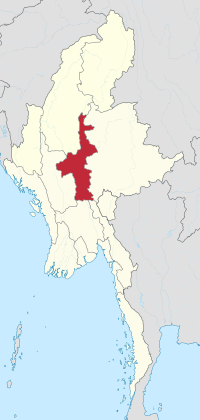Mandalay Division
|
Mandalay Region မန္တလေးတိုင်းဒေသကြီး |
||
|---|---|---|
| Region | ||
| Myanma transcription(s) | ||
| • Burmese | manta.le: tuing: desa. kri: | |
|
||
 Location of Mandalay Region in Myanmar |
||
| Coordinates: 21°0′N 95°45′E / 21.000°N 95.750°ECoordinates: 21°0′N 95°45′E / 21.000°N 95.750°E | ||
| Country |
|
|
| Region | Central | |
| Capital | Mandalay | |
| Government | ||
| • Chief Minister | Zaw Myint Maung (NLD) | |
| • Cabinet | Mandalay Region Government | |
| • Legislature | Mandalay Region Hluttaw | |
| Area | ||
| • Total | 37,945.6 km2 (14,650.9 sq mi) | |
| Area rank | 7th | |
| Population (2014) | ||
| • Total | 6,165,723 | |
| • Rank | 3rd | |
| • Density | 160/km2 (420/sq mi) | |
| Demographics | ||
| • Ethnicities | Bamar, Chinese, Shan, Chin, Kayin, South Asians | |
| • Religions | Buddhism, Christianity, Hinduism, Islam | |
| Time zone | MST (UTC+06:30) | |
| Website | www |
|
Mandalay Region (Burmese: မန္တလေးတိုင်းဒေသကြီး, pronounced: [máɴdəlé táiɴ dèθa̰ dʑí], formerly Mandalay Division) is an administrative division of Myanmar. It is located in the center of the country, bordering Sagaing Region and Magway Region to the west, Shan State to the east, and Bago Region and Kayin State to the south. The regional capital is Mandalay. In the south of the division lies the national capital of Naypyitaw. The division consists of seven districts, which are subdivided into 30 townships and 2,320 wards and village-tracts.
Mandalay Region is important in Myanmar's economy, accounting for 15% of the national economy. It is under the administration of the Mandalay Region Government.
The history of Mandalay Region is the same as that of much of Upper Myanmar except that for much of Burmese history, the political power emanated out of royal capitals located in Mandalay Region. The country's present capital, Naypyidaw, and most former royal capitals of the Burmese nation--Bagan, Ava, Amarapura, Mandalay—are all located here.
The Tibeto-Burman speaking Pyu were the first historical people to dominate the dry zone in central Myanmar that includes Mandalay Region as early as the 1st century AD. By the early 9th century, the Pyu were decimated in a series of wars with the Nanzhao kingdom from Yunnan. The Burmans, who had been migrating into the region from Yunnan in the 9th century, founded a city of their own, Pagan, in 849. The Pagan dynasty gradually came to dominate the central zone over the next two centuries, and by the late 11th century, all of present-day Myanmar. The Burmese language and script came to prominence with royal patronage of Pagan kings.
...
Wikipedia

